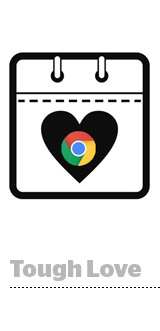
There’s no love for annoying ads on Chrome this Valentine’s Day. Google released a new version of its browser on Wednesday with a built-in ad blocker. Here’s how it works.
Chrome will now block all ads on sites that don’t adhere to the ad quality standards set by the Coalition for Better Ads, an industry group that counts Google, Facebook, P&G, the Interactive Advertising Bureau and the Association of National Advertisers among its members.
The coalition has defined 12 ad experiences that will trip the blocker across desktop and mobile, including pop-up ads, autoplay video with sound, prestitial ads with and without countdown clocks, large sticky ads, full-screen scroll-overs and flashing animated ads. Ad density higher than 30% on mobile is also no bueno.
After Chrome alerted publishers of its plans to block noncompliant ads in June, Google released the Ad Experience Report that lets publishers test their sites for infractions and fix any issues.
Sites are considered in violation if more than 7.5% of their page views include a crappy ad experience, as per the coalition standards. Pubs with a failing status are alerted and get a 30-day grace period to mend their ways before Chrome starts blocking ads.
For persistently bad sites, Chrome will filter ads at the network level.
When users visit a publisher, Chrome’s blocker checks to see if the page in question belongs to a failing site. If so, Chrome will block any network requests coming from JavaScript or images that display ad-like URL patterns based on EasyList, the same open-source block list that powers Adblock Plus.
All ads will be blocked from appearing on a failing site, including those coming from Google-owned ad platforms AdSense and DoubleClick. Display ads on the YouTube desktop site will also be reviewed against the Better Ads Standard.
“There’s a misconception that Google will somehow carve out an exception for its own website or ad platforms, but that’s not the case,” said Ryan Schoen, a Chrome product manager. “The standard is being applied evenly and we’ll be removing Google ads from sites if they’re in violation.”
Ads will be blocked automatically until a misbehaving site undergoes another review to prove that it’s in compliance.
Until then, users will see a message on their screens notifying them that ads are being blocked, along with an option to disable the blocking.
Offending sites will even have non-intrusive ads blocked. There are two reasons for that, Schoen said.
“For one, on a technical level, it would be very difficult to surgically remove specific ads, because one ad script or provider is often responsible for multiple ads on a site,” he said. “Secondly, certain experiences in the standard aren’t specific to a single ad creative or placement, but rather a combination of ads above a certain density.”
According to Google, most reputable publishers already have their ducks in a row and won’t have to worry about the Chrome ad blocker killing their revenue.
In early February, Google said that just 1% of publishers are not compliant, based on an audit of more than 100,000 sites across North America and Europe. Google also noted that 42% of sites that were in violation (923 failures and 345 at the warning level) fixed their ad issues by Feb. 12. That list of sites now in the clear includes Forbes, Los Angeles Times, Chicago Tribune and In Touch Weekly.
The purpose of the blocker is to make surfing the web more enjoyable, not to throttle a legit publisher’s need to monetize. And the bigger-picture hope is that filtering bad ads on Chrome doesn’t just end up being a Chrome thing, Schoen said.
“This is about beating the drum about improving user experience for all users on the web,” he said. “The ultimate goal is that all publishers move away from annoying ad experiences.”
This post was syndicated from Ad Exchanger.

More Stories
Dismantling Google Will Not Fix the Adtech Ecosystem
Meta’s Threads Begins Global Ad Rollout Within Its Feed
Adtech Firm Criteo Is Pitching Hundreds of Retailers on a New Video Ad